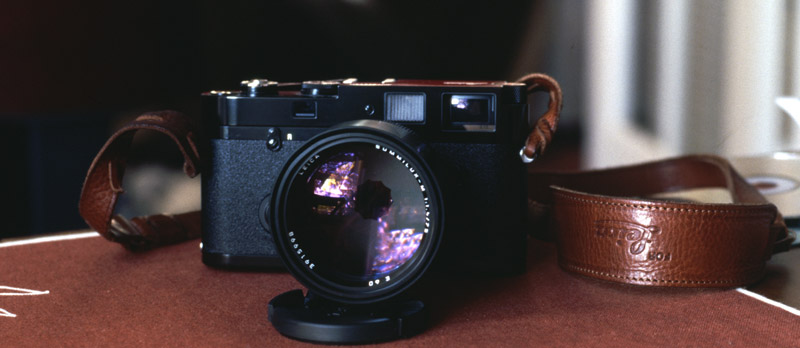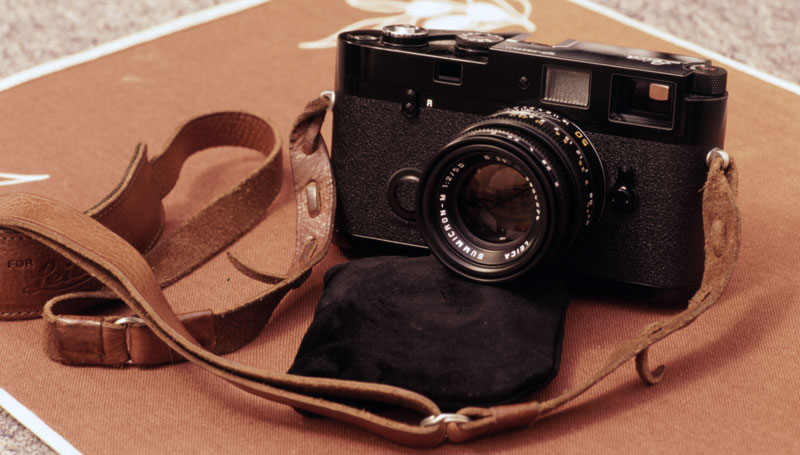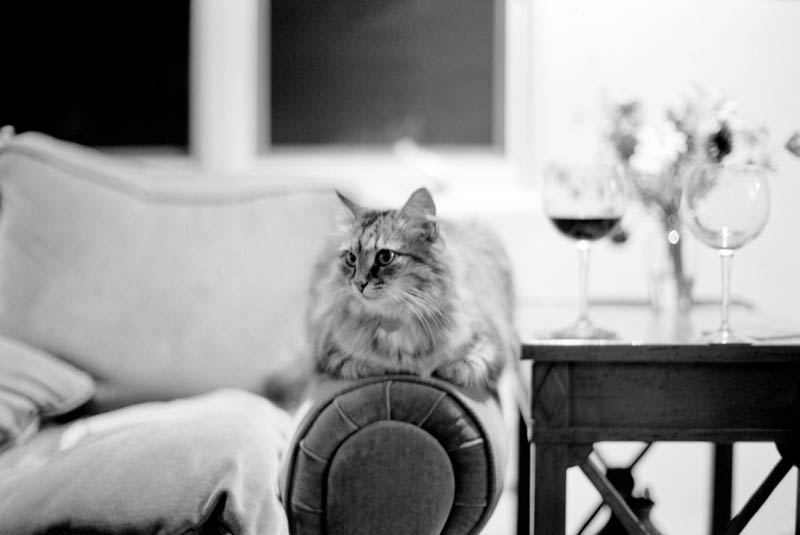
The Leica MP is perhaps the ultimate manual rangefinder camera. It is a superbly crafted camera which is not only highly functional, but beautiful in its own right. It maintains the classic styling of the Leica M3 and adds a meter and more modern finder. There is some controversy in the Leica community as to whether the MP is just a "fondler's" camera or the apotheosis of the Leica M. The detractors say that the lack of the most modern features -- a modern rewind crank, TTL metering and AE operation -- makes the MP a collector's camera. By extension, since the M7 has AE operation and an electronic shutter, these detractors claim that to eschew these utilitarian features for the style of the MP is tantamount to buying it as "man-jewelry". I believe that if you are using a Leica in the first place, you are more concerned with the aesthetics of a camera than with functionality. Most normal camera manufacturers added the above features in the sixties or seventies. The fact remains that comparing an M7 to a EOS 1V, which among other things auto-focuses based on the movement of your frikkin' eye, is like comparing a bow and arrow to a Tomahawk missile. The point is that both the M7 and MP are anachronisms -- beautiful ones at that.
The main components of the MP are made from brass and the camera is heavier than the M6 classic. Leica had originally switched from brass gears to steel when they felt the need to add a motor drive for the M series. Brass gears are smoother than steel gears, but they do not stand up to the same level of punishment with respect to motor drives. Leica also decided to bring back the black paint finish for the new MP. The camera is also available in a silver chrome finish. After the M3, Leica abandoned the black paint finish for the more durable black chrome finish. Though it is more durable, the black chrome finish lacks the elegance of black paint, and it does not wear as handsomely. When the black paint finish wears, the brass under the paint shows, offering a beautiful black and brass finish. Black chrome looks a bit more unkempt -- the black chrome becomes a bit shinier and shows silver bright spots when it wears. It does not look as nice. Obviously, this change is sheer vanity, but I don't see anyone questioning people's desire for more than one color on a car. Why should a camera be any different?

But what does the MP offer as a functional camera? Regardless as to how you feel about Leica's choices in making the camera, it makes sense to evaluate it on what it is. Though the camera is jewel-like in its execution, it truly is built to be used professionally (or at least professionally 30 years ago). The camera feels like a brick. It is incredibly solid. It weighs 600 grams without a lens or strap -- this is about the same as the M7, though the MP is smidgen shorter. It is noticeably heavier than an M6 classic. Ergonomically, it feels exquisite in the hand. The film advance lever is in the perfect position and the overall smoothness of the camera is unmatched by any camera I have ever used. This is not a biased account. I think the Canon F1-N's advance lever is better designed, but it is much rougher. Nothing short of an M3 feels like an MP. It is like you are holding "Photography" in your hand. This feeling is enhanced by using one of Luigi Crescenzi's built-in grip cases. Without the half-case, the MP feels great, but Luigi's case makes it even easier to hold and more ergonomic.
The finder is extraordinarily bright -- brighter than the finder of the M6 classic. It has been multi-coated and improved so that it does not flare when in difficult lighting situations. I find it as easy to shoot in low light situations as my Canon FD with f/1.2L lenses. The area which the MP excels in however, is unobtrusive photography. The cloth shutter in the MP is extraordinarily quiet. While an SLR needs to move a mirror out of the way before exposing the film, a rangefinder can avoid this loud step. Furthermore, by avoiding a metal shutter, the Leica keeps it shutter release quieter than most professional cameras (excluding the Hexar AF, TLR's and some leaf shutter cameras). While this may not seem like a big deal, a quiet shutter release actually puts many people at ease and aids in candid photography. Beyond this, there is an advantage in slow shutter speed photography. The slap that results when an SLR mirror is raised results in a great deal of vibration in the camera body. This vibration leads to a loss of sharpness in slow shutter speeds (below 1/30th of a second). As a rangefinder, the MP allows you to photograph at much lower shutter speeds without an apparent loss of sharpness. If I have not had much caffeine that day, I can usually photograph successfully at 1/8th. Higher speeds lead of course to sharper pictures, but even 1/8th will produce an acceptable shot. Here is an example of the MP shot at 1/8th and f/1.2 using the Konica M-Hexanon 50mm f/1.2 lens:

Perhaps what I love about the MP most, however, is how much it makes you think about the photographic process. With the MP, there are only three adjustments that matter -- focus, f stop, and shutter speed. Once you have loaded film into the MP and set the ISO, all you need to worry about is what lens you want to use (field of view and speed), focus, what f stop you would like to use (depth of field), and what shutter speed you want to use (control of motion). The process is very simple, but it forces you to think about every shot. Especially when starting out as a serious photographer, this simplification is quite useful. The MP is not a camera where you can simply put it on autopilot and expect to get good pictures. However, if you have an understanding of the basics you will get excellent results. The meter is excellent. If you find the average point of a given scene, the MP meter will tell you an accurate exposure value.
The biggest advantage of the Leica MP, however, is the lens selection that comes with it. If you are not concerned with cost, the M lenses are among the best made for any system and any format. Though I have not used the 45mm f/2 planar myself, I would be surprised if it surpassed the Leica 50mm Summicron M. I have never used a lens that has the same level of contrast and resolution. When switching from Canon L series lenses, the only lens that I noticed a difference on was the summicron M. The difference was not subtle. The level of resolution and three dimensionality is simply astonishing. In addition to this, the 35mm Summilux ASPH, 75mm Summilux and 90mm Tele-Elmarit M are astounding lenses. Another benefit is that as an M user you have access to 80 years of lenses. All Leica screwmount lenses fit on the M series using a simple, inexpensive adapter. This includes the excellent Canon and Nikon rangefinder lenses of the sixties and seventies. In the past several years, the Japanese optics company Cosina has offered a number of modern lenses in Leica M mount under the Voigtlander name. Voigtlander lenses are very cheap, yet they are of exceedingly high quality. Though they may not match current Leica offerings, they are very close -- indistinguishable for most purposes. This wide selection of lenses means that focal lengths from 12mm to 135mm are fully covered, including a number of super-speed lenses like the 50mm f/1.0 Noctilux, several f/1.2 lenses and a large number of f/1.4 lenses in 35,40,50,75, and 85mm focal lengths.
Overall, the MP is an incredible camera for available light discreet photography. It also excels at travel photography dues to its small size and quiet operation. It is the perfect synthesis of design and function resulting in a camera that is as lovely to use as it is to behold.